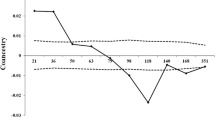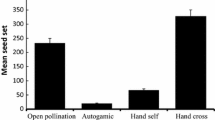Abstract
The influence of different pollen donors on seed formation was investigated in three populations ofEspeletia schultzii that differ in environmental conditions and life history characteristics. Self pollen and pollen from different donors (< 15m apart) within each population was used in a diallel design in order to test the genetic base of seed set variation. Three measures of seed formation were used: (1) achene number; (2) proportion of filled achenes (fruits) that distinguishes between achenes with seeds and empty achenes; (3) proportion of aborted seeds that distinguishes between viable and aborted seeds. Self-pollinations resulted in empty achenes. Achene number did not vary between the different pollen donors. A bimodal pattern of filled achenes was found in two populations in two consecutive years. On the other hand, a unimodal pattern was found in crosses between more distant donors (> 30m). These patterns seems to be the results of a sporophytic incompatibility system. Seed abortion was highest at the higher elevations and seems to be correlated with elevation rather than with any genetic effect.
Similar content being viewed by others
References
Antonovics, J., Schmitt, J., 1986: Paternal and maternal effects on propagule size inAnthoxanthum odoratum. — Oecologia69: 277–282.
Baruch, Z., 1979: Elevational differentiation inEspeletia schultzii (Compositae), a giant rosette plant of the Venezuelan paramos. — Ecology60: 85–98.
—,Smith, A. P., 1979: Morphological and physiological correlates of niche breadth in two species ofEspeletia (Compositae) in the Venezuelan Andes. — Oecologia38: 71–82.
Bawa, K. S., 1974: Breeding systems of trees species of a lowland tropical community. — New Zealand J. Bot.28: 85–92.
—,Beach, J. H., 1983: Self-incompatibility systems in theRubiaceae of a Tropical Lowland Wet Forest. — Amer. J. Bot.70: 1281–1288.
—,Webb, C. J., 1984: Flower, fruit and seed abortion in tropical forest trees: implications for the evolution of paternal and maternal reproductive patterns. — Amer. J. Bot.71: 736–751.
Berry, P., Calvo, R., 1989: Wind-pollination, self-incompatibility and altitudinal shifts in pollination systems in the High Andean genusEspeletia (Asteraceae). — Amer. J. Bot. (in press).
Bertin, R. I., 1982: Paternity and fruit production in trumpet creeper (Campsis radicans). — Amer. Nat.119: 694–709.
—, 1985: Non-random fruit production inCampsis radicans: between year consistency and effects of prior pollination. — Amer. Nat.126: 750–759.
—, 1986: Consequences of mixed pollinations inCampsis radicans. — Oecologia70: 1–5.
Bookman, S. S., 1984: Evidence for selective fruit production inAsclepias. — Evolution38: 72–86.
Carr, G. D., Powell, E. A., Kyhos, D. W., 1986: Self-incompatibility in the HawaiianMadiinae (Compositae): an exception toBaker's rule. — Evolution40: 430–434.
Crowe, L. K., 1954: Incompatibility inCosmos bipinnatus. — Heredity8: 1–11.
—, 1971: The polygenic control of outbreeding inBorago officinalis. — Heredity27: 111–118.
De Nettancourt, D., 1977: Incompatibility in angiosperms. — Berlin, Heidelberg, New York: Springer.
Gerstel, D. U., 1950: Self-incompatibility studies in Guayule. 2. Inheritance. — Genetics35: 482–506.
Grabe, D. F., 1970: Tetrazolium testing handbook. Contribution No 29 to the handbook on seed testing. — Association of Official Seed Analysts.
Guariguata, M., 1985: Dispersion, dinamica del banco de semillas y germinacion deEspeletia timotensis (Cuatr.). — Thesis. Univ. Simon Bolivar. Caracas.
Harder, L. D., Thomson, J. D., Cruzan, M. B., Unnasch, R. S., 1985: Sexual reproduction and variation in floral morphology in an ephemeral vernal lily,Erythronium americanum. — Oecologia67: 286–291.
Hughes, M. B., Babcock, E. B., 1950: Self-incompatibility inCrepis foetida L. subsp.rhoeadifolia (Bieb.)Schinz & Keller. — Genetics35: 570–588.
Janzen, D. H., Devries, P., Gladstone, D. E., Higgins, M. L., Lewinsohn, T. M., 1980: Self- and cross-pollination ofEncylica cordigera (Orchidaceae) in Santa Rosa National Park, Costa Rica. — Biotropica12: 72–74.
Knox, R. B., 1973: Pollen wall proteins: pollen stigma interactions in ragweed andCosmos (Compositae). — J. Cell Science12: 421–443.
Koptur, S., 1984: Outcrossing and pollinator limitation of fruit set: breeding systems of neotropicalInga trees (Fabaceae: Mimosoideae). — Evolution38: 1130–1143.
Lee, T. D., Bazzaz, F. A., 1982: Regulation of fruit maturation pattern in an annual legume,Cassia fasciculata. — Ecology63: 1374–1388.
Levin, D. A., 1981: Dispersal versus gene flow in plants. — Ann. Missouri Bot. Gard.68: 233–253.
—, 1983: Plant parentage: an alternative view of the breeding structure of populations. — InKing, C. F., Dawson, P. S., (Eds.): Population biology—retrospect and prospect, pp. 171–188. — New York: Columbia University Press.
—, 1984: Inbreeding depression and proximiy dependent crossing success inPhlox drummondii. — Evolution38: 116–127.
Marshall, D. L., Ellstrand, N. C., 1984: Proximal causes of multiple paternity in wild radish,Raphanus sativus. — Amer. Nat.126: 596–605.
Martin, F. W., 1959: Staining and observing pollen tubes in the style by means of fluorescence. — Stain Technol.34: 125–128.
Mazer, S. J., 1987: Parental effects on seed development and seed yield inRaphanus raphanistrum: implications for natural and sexual selection. — Evolution41: 355–371.
Meinzer, F., Golstein, G., Rundel, P. W., 1985: Morphological changes along an altitudinal gradient and their consequences for an andean giant rosette plant. — Oecologia85: 278–283.
Monasterio, M., Reyes, S., 1980: Diversidad ambiental y variacion de la vegetacion en los paramos de los Andes Venezolanos. — InMonasterio, M., (Ed.): Estudios ecologicos en los paramos andinos, pp. 45–91. — Merida, Venezuela: Ediciones de la ULA.
Mulcahy, D. L., Mulcahy, G. B., 1983: Gametophytic self-incompatibility reexamined. — Science220: 1247–1251.
Ockendon, D. J., 1974: Distribution of self-incompatibility alleles and breeding structure of open-pollinated cultivars of Brussels sprouts. — Heredity33: 159–171.
Price, M. V., Waser, N. M., 1979: Pollen dispersal and optimal outcrossing inDelphinium nelsonii. — Nature277: 294–296.
Sampson, D. R., 1964: A one-locus self-incompatibility system inRaphanus raphanistrum. — Canad. J. Genet. Cytol.6: 435–445.
—, 1967: Frequency and distribution of self-incompatibility alleles inRaphanus raphanistrum. — Genetics56: 241–251.
Schemske, D., W., Pautler, L. P., 1984: The effects of pollen composition on fitness components in a neotropical herb. — Oecologia62: 31–36.
Smith, A. P., 1981: Growth and population dynamics ofEspeletia (Compositae) in the Venezuelan Andes. — Smithson. Contrib. Bot.48: 1–45.
Snow, A., 1982: Pollination intensity and potential seed set inPassiflora vitifolia. — Oecologia55: 231–237.
Sobrevila, C., 1986: Experimental studies on seed production in natural populations ofEspeletia schultzii Wedd. — PhD. Thesis, Harvard Univ.
—, 1988: The effects of distance between pollen donor and pollen recipient on fitness components ofEspeletia schultzii. — Amer. J. Bot.75: 701–724.
Sokal, R. R., Rohlf, F. J., 1981: Biometry. — San Francisco: W. H. Freeman & Co.
Stephenson, A. G., 1981: Flower and fruit abortion: proximate causes and ultimate functions. — Ann. Rev. Ecol. Syst.12: 253–279.
SYSTAT, 1984: (Wilkinson, L., Ed.) Systat: the system for statistics. — Evanston, Illinois: Systat Inc.
Thompson, K. F., 1957: Self-incompatibility in marrow-stem kale,Brassica oleraceae var.acephala. 1. Demonstration of a sporophytic system. — J. Genetics55: 45–60.
Van der Kloet, S. P., 1984: Effects of pollen donors on seed production, seed weight, germination and seedling vigor inVaccinium corymbosum L. — Amer. Midl. Nat.112: 392–396.
Waser, N. M., Price, M. V., 1983: Optimal and actual outcrossing in plants and the nature of plant pollinator interaction. — InJones, C. E., Little, R. J., (Eds.): Handbook of experimental pollination biology, pp. 341–359. — New York: Van Nostrand Reinhold.
Williams, W., 1947: Genetics of red clover (Trifolium pratense L.) compatibility. 3. The frequency of incompatibility S alleles in two non-pedigree populations of red clover. — J. Genetics48: 69–79.
Willson, M. F., Burley, N., 1983: Mate choice in plants: tactics, mechanisms, and consequences. — Princeton, N. J.: Princeton University Press.
Zapata, T. R., Arroyo, M. T. K., 1978: Plant reproductive ecology of a secondary deciduous tropical forest in Venezuela. — Biotropica10: 221–230.
Author information
Authors and Affiliations
Rights and permissions
About this article
Cite this article
Sobrevila, C. Effects of pollen donors on seed formation inEspeletia schultzii (Compositae) populations at different altitudes. Pl Syst Evol 166, 45–67 (1989). https://doi.org/10.1007/BF00937875
Received:
Revised:
Issue Date:
DOI: https://doi.org/10.1007/BF00937875




